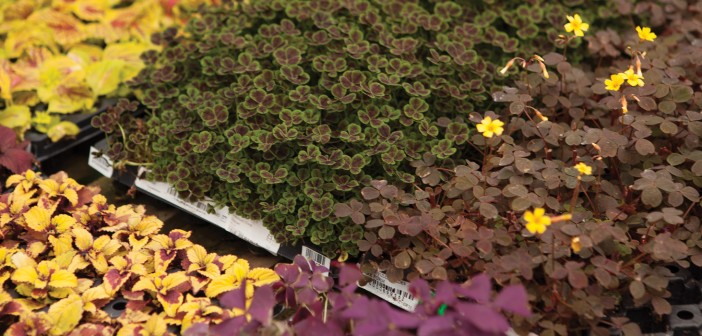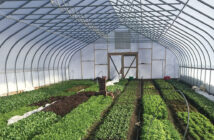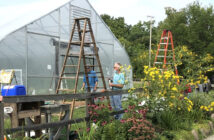With a little more sunshine pushing away the dreary clouds of a frigid Michigan winter, you might be itching to put on your favorite garden gloves and go work outside. Before you start clearing debris from the landscaping and preparing your garden soil for the prospects of new growth, consider these garden trends and tips from local experts. Whether you prefer to keep your yard or garden very simple with just a few shrubs and perennials or lush with a variety of plant species and blooms, gardening experts offer some ideas to get you started this spring.
Check out the 2015 Bee Symposium, on April 20, 5-8:30 pm at the Regional Technology Center at Mott Community College. View the film “Saving the Lifekeeper,” which covers beekeeping, power plants that attract bees, urban farming and other helpful expert gardening tips. There will also be vendors and a native plant sale.
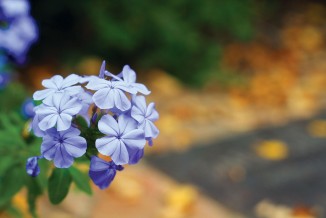 Pollinator-Friendly Plants
Pollinator-Friendly Plants
Michigan gardeners are expected to continue to seek more pollinator-friendly plants, trees and flowers to add to their garden plan this year. Birds, bats, bees and insects transfer pollen among flowers support the ecosystem and are important for the reproduction of many native plants and fruit trees. However, the U.S. Fish & Wildlife Service warns that new roadways, manicured lawns, crops, non-native gardens and the improper use of pesticides all continue to threaten pollinators and their habitats. Bee colonies have especially declined in numbers in recent years, resulting in a nationwide public awareness campaign to encourage gardeners to include plants that attract honey bees, bumble bees and various native bees.
Ideal gardens incorporate a variety of perennials, annuals, and flowering trees and shrubs so that looking out your window, you’ll see bee-loving blooms somewhere in the garden all summer long. MSU Extension experts advise that another important benefit of flowering plants is to provide nectar and pollen for hundreds of species of tiny parasitic wasps (that don’t sting humans) and predators that help to keep plant-feeding insects under control. A few colorful options that will keep the bees happily buzzing include daisies, salvia, coneflowers, marigolds and hardy mums.
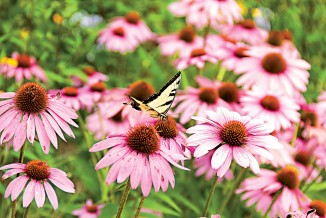 “There are many good sources of food for the butterflies, bees and wasps and various insects that fly and live off that nectar in the flowers” says Jim Harrow, MSU Extension Master Gardener Coordinator for Genesee County. Butterfly bushes attract bees and butterflies including Monarchs, Swallowtails and many other species. Butterfly bushes will enhance any garden or fence line with their colorful blooms. They’re hardy and grow well in sunny or partly shady spots and in well-drained soil.
“There are many good sources of food for the butterflies, bees and wasps and various insects that fly and live off that nectar in the flowers” says Jim Harrow, MSU Extension Master Gardener Coordinator for Genesee County. Butterfly bushes attract bees and butterflies including Monarchs, Swallowtails and many other species. Butterfly bushes will enhance any garden or fence line with their colorful blooms. They’re hardy and grow well in sunny or partly shady spots and in well-drained soil.
Butterflies are drawn to purple coneflower, coreopsis, zinnias, Mexican sunflower and Blazingstar. Consider balancing out your butterfly bushes with caterpillar-friendly plants such as swamp milkweed, clover, dill, parsley and tulip trees. Prune these bushes occasionally and remove dead flowers to encourage plant growth and flower production during the summer. Other beautiful pollinators include hummingbirds, which love tubular-shaped, bright (especially red) flowers. Consider adding trumpet creeper, cardinal flower, columbine or beebalm to your flower beds to provide natural food sources for hummers to enjoy.
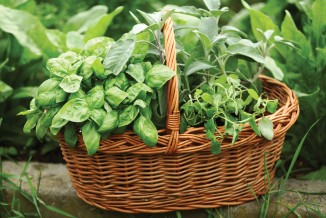 Native Species
Native Species
Gardeners are starting to make room for more native species in their garden plans. Mel Kennedy is public relations administrator for The Wild Ones, an organization promoting landscaping with native plants. Mel advises folks to include plants and flowers that are native to Michigan, adding natural diversity to any garden or yard. “You want to have plants that attract the native pollinators and native bees and honey bees,” he says.
Native plants are best adapted to the local growing season, climate and soils. Some examples of Michigan-native plants that like shady areas include witch hazel, eastern hemlock, ferns, jack-in-the-pulpit, spring beauty, large-leaved aster, blue phlox, bloodroot, violets and cardinal flower. Native species that attract butterflies and caterpillars include dogwoods, plums, oaks, willows, staghorn sumac, tickseeds, wild lupine, black-eyed Susans and sunflowers.
Taking some time to research the plants going into your landscape is worth the effort. “You have to do your homework,” Mel says. “People will sometimes go and get a plant growing along a roadside and don’t know that it’s an invasive species.”
Other invasive species that are difficult to control include bamboo, Japanese knotweed, purple loosestrife and even some herbs like mint and oregano. These plants will spread rapidly to areas where they are not welcome. “If purple loosestrife gets into a water system, it tries to push out the native species,” explained Jim Harrow with MSU Extension.
Bees are attracted to mint, and it has many tasty uses in the kitchen, but the plant can spread quickly. One way gardeners can slow the spread of mint plants is to deposit the containers (with drainage holes) in the ground at least eight inches deep with the top of the containers slightly above ground level.
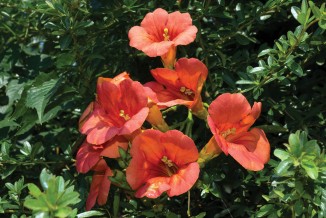 If you’re thinking about adding a beautiful walnut tree to your landscape and planting a veggie garden near it, think again. Walnut trees are highly prized for their nuts, wood and shade, but their roots produce a toxin called juglone.
If you’re thinking about adding a beautiful walnut tree to your landscape and planting a veggie garden near it, think again. Walnut trees are highly prized for their nuts, wood and shade, but their roots produce a toxin called juglone.
“A 20- to 30-foot walnut tree’s root spread is around 60 feet,” Jim explained. “This toxin keeps other plants from growing within the spread of the roots.” So veggie plants like tomatoes, potatoes and eggplant won’t thrive near a walnut tree. Hickory trees also produce a chemical that deters growth of neighboring plants.
Mark and Kay Porter have operated Ken’s Greenhouse on Lavelle Road in Flint since 1995. The business has been in the family for over 40 years, started by Mark’s parents Ken and Velma. Mark’s grandfather Walter Porter ran a family greenhouse around the corner from them in the ‘50s. My City Magazine visited Ken’s Greenhouse early last month when snow was still piled up against the greenhouses, while indoors the Porters were growing new seedlings and reviewing their seed and planting supplies in preparation for spring.
Several kinds of tomatoes are available on the market, but even certain varieties have more fans than others. “Red Robin tomatoes are replacing the patio tomatoes,” Mark explained. “The patio tomatoes fizzle out faster.”
Gardeners are using bigger planters and mixing herbs with flowers for color, adds Kay. People also like to use hanging planters to grow cherry and grape tomatoes as well as strawberry plants.
“The key is keeping them watered,” Kay says. “Eventually the soil will leech out, so you want to keep adding soil to it. A little powdered milk sprinkled on the soil adds beneficial calcium to it.”
Edible Container Gardens
For busy people who do not have a lot of extra time to weed and water a traditional vegetable garden, setting a decorative pot containing a lovely vegetable plant on a deck or porch is a fast-growing trend. They add greenery and color, and you can conveniently harvest the produce throughout the summer and fall months by simply stepping out your back door to get what you need. Many varieties of lettuce, peppers and tomatoes are popular patio-pleasers.
“More people are planting vegetables in containers,” says Mark Porter, owner of Ken’s Greenhouse. “They don’t have room for gardens. We’ve got 15 types of peppers now. Compared to flowers, our vegetable sales have gone up.”
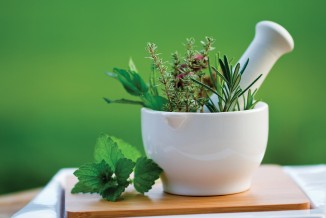 Low-Maintenance Options
Low-Maintenance Options
If you want a plant or flower that doesn’t need a lot of attention but is still pleasing to the eye, consider herbs like basil or dill, succulents like aloe or hens ‘n chicks, and flowers like tulips, lilies, begonias, sunflowers, pansies and geraniums. Hens ‘n chicks tolerate dry, poor soil very well.
At Ken’s Greenhouse, begonias are popular among customers who want color in their landscape. They can also withstand an owner forgetting to water on occasion. “We sell a lot of begonias because they’re drought tolerant,” Mark says.
To keep flowers and plants happy and lower-maintenance through the growing season, be sure to nourish their root systems with good-quality compost. Work a two-inch base of compost into the soil in the fall if possible. Include grass clippings (from untreated lawns) and broken-up dead leaves, vegetable peelings, coffee grounds and eggshells. The compost will break down during the winter, adding nitrogen, phosphorous and potassium to the ground, and then it’ll be ideal for your spring plants.
You can also buy compost in bags or use tried-and-true cow manure, which makes excellent compost. When shopping at your local garden center, experts recommend asking questions about the kind of composts for sale as some types contain weed seeds.
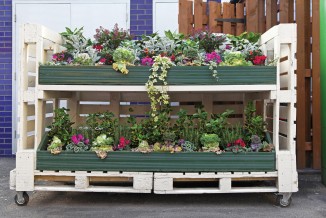
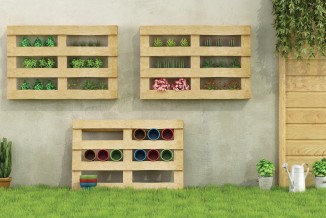 Pallet Planters Make Pretty Space-Savers
Pallet Planters Make Pretty Space-Savers
Planters made from used wooden pallets and set either vertically or horizontally can add interest to a yard or front porch. Vertical pallets are perfect if you don’t have much of a yard to work with. Pallets can be painted bright colors and cut to smaller sizes to fit a desired space or decorated to suit your unique garden decor. “Lettuces or herbs or colorful annuals grow well in those,” says Kay. “If there’s a high wind, you’d want to secure it.” They can be secured by connecting two pallets together to make a tee-pee, building a wide wooden base or permanently fastening a pallet to a fence.
Though the Porters have been growing plants and flowers at Ken’s Greenhouse for many years, they are quick to point out that anyone can research a plant or flower and learn how to take care of it properly. “Look it up online or pick up a gardening book,” says Kay, smiling. “Just because you don’t know anything about a garden doesn’t mean you can’t learn it.”

